.
The Grasshopper
and
The Corliss
MILESTONES
in the Mighty Age of Steam

South Station which houses the Grasshopper locomotive in Carillon Park.
South Station is a modest little building, representing in its style of construction a typical railroad station in the days when the railroad first came to the Miami Valley. However, its function is not to provide a waiting place for passengers but to serve as the home of one of the oldest locomotives still in existence. The miniature power house across the way is much more modern in its construction. The Corliss engine which has been re-erected in this building was in operation at NCR for almost fifty years.
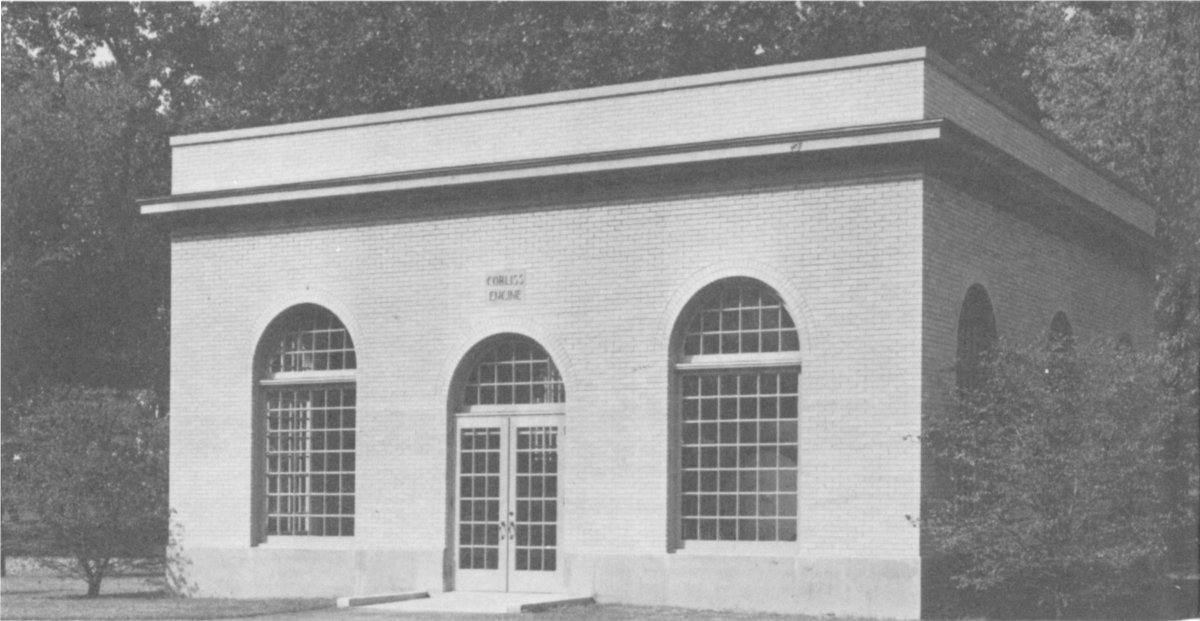
The Corliss Engine Building has much the appearance of a small power house.
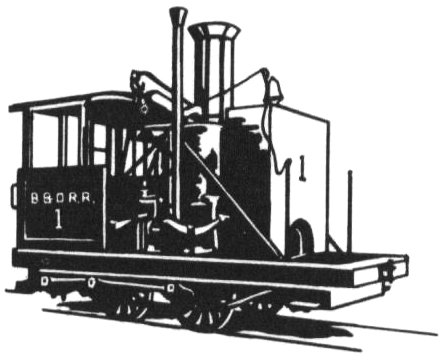
When James Watt gave the world the condensing steam engine in 1788 he ushered in an era in man’s progress which brought with it the Industrial Revolution and fundamental changes in our way of life. Steam has made possible the development of our vast industries, our modern transportation on land and on sea, and an immeasurable expansion of the horizons of our daily life.
Two of the most far-reaching uses of the principle of production of power through steam have been in transportation and in the generation of electricity. In both instances the first steps toward the ultimate achievement were crude and none too convincing, but they did lead to further development and outstanding accomplishment.
After the discovery of the power of steam, man toyed with the idea of a steam engine that could move itself. The implications of such an invention were far reaching. The first steps were taken in England in the early part of the nineteenth century and a locomotive which successfully hauled a train of vehicles was built there in 1825. The first American locomotive was the Tom Thumb built by Peter Cooper.
In a competition sponsored by the Baltimore and Ohio Railroad, Phineas Davis, a watchmaker of York, Pennsylvania, built a locomotive which was referred to as the “grasshopper” type because of its appearance and the up-and-down motion of its driving rods. This was really the first successful steam railroad engine in this country.
Turning to the stationary steam engine for the production of direct power and for generating electricity, we find that the greatest advance in this field was the Corliss engine. This engine which incorporated new principles of control and fuel economy was the invention of George H. Corliss, a New England inventor who, as much as any other man, was responsible for the development of the power facilities which have made possible the industrialization of this nation.
The Grasshopper locomotive and the Corliss engine, each in its own way, made a vital contribution to the development of America. Each is included in the Carillon Park exhibits because it represents a significant forward step in man’s constant quest for a better and fuller life.
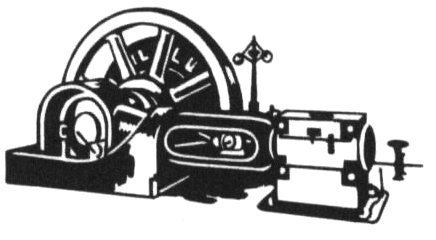
Steam Comes to the Rails

The famed “Atlantic” drawing early type railroad coaches in Baltimore and Ohio railroad exhibit. The “Atlantic” is original, the coaches replicas.
The steam railroad represents an evolution unique in the story of man’s progress. Its expansion from almost primitive beginnings unfolds one of the epics of transport. Today’s network of steel rails is tribute to the originality and persistency of courageous and far-seeing men.
Nowhere has the railroad undergone such a transformation as in the United States. Although England stood in the van of locomotive construction, American ingenuity perfected the most powerful type. From an average of twelve to fourteen tons, the weight of the first Grasshopper engine, they have expanded to the monsters of more than five hundred tons. In 1840, a little more than a decade after the incorporation of our first railroad, the total mileage in this country was 2,810. Today the operated mileage is 398,000.
The real birth of the railroad, however, was in England. As in the United States, tramways provided the predecessor. They were first employed in the coal districts adjacent to Newcastle, to convey coal from the pits to the River Tyne for shipment abroad.
The weakness in all the early British engines was that they could not produce steam as rapidly as they used it up, nor did they have sufficient power to move quickly, or pull more than their own weight. It remained for George Stephenson to overcome these weaknesses and prove the practicability of the movable steam locomotive. Stephenson, born in 1781, was the son of a fireman at the Wylam Colliery near Newcastle. Stirred by the story of James Watt’s achievements in the domain of steam, George enrolled in a night school to study mechanics.
Steam traction continued to absorb the attention of many British inventors, so Stephenson turned to it. He constructed an engine called “Blucher,” which made a successful trial run July 25, 1814.
George Stephenson was a persistent fellow. To his doggedness of purpose we owe the beginning of the steam railroad. In 1822 he “sold,” as we would say today, the directors of the Stockton & Darlington Railway, which had planned to use horses on its trams, on the idea of using a steam locomotive. He was appointed engineer of the road and given authority to carry out his plans.
The age of railroading in this country began with the chartering in 1827 of the Baltimore & Ohio Railroad, the first road constructed in the United States to carry passengers and freight. The first rails were laid on July 4, 1828, with Charles Carroll, the only living signer of the Declaration of Independence, turning over the first spadeful of dirt. The first section of thirteen miles from Baltimore to Ellicott’s Mills was opened in May, 1830. The man who jolted the Baltimore & Ohio directors out of their horse fixation was the renowned Peter Cooper.
Cooper built a locomotive which he called Tom Thumb. The name was apt because it was quite a small affair. In its construction he used odds and ends of mechanical parts. The barrels of muskets, for example, provided the tubes for the upright boiler.
The directors of the Baltimore & Ohio decided to have a competition. In January, 1831, they advertised for locomotives to be entered in a series of contests. They offered to give a $4,000 prize for the locomotive that best met the test, and $3,500 for the second best engine.
Four engines entered the competition, one of which was built by Phineas Davis, a watchmaker of York, Pennsylvania. The Davis entry fulfilled all the requirements of the competition and won first prize. Soon after its adoption the Baltimore & Ohio directors named that type of locomotive the Grasshopper. This was due to its grasshopper-like construction. From that parent engine sprang a fleet of Grasshoppers that operated for nearly a century and made railroad history.
Phineas Davis and his partner, Gartner, now began to develop the Grasshopper type. The next venture was the Atlantic which went into service on the B & O in the summer of 1832. Once the Grasshoppers demonstrated their utility, the steam locomotive idea spread rapidly.
The saga of the American Railroad is a stirring narrative of triumph over obstacles. The road of the iron horse is part of the larger highway over which progress has marched. In that drama of achievement the Grasshopper locomotive played its full part. As such, it merits a niche in the Transport Hall of Fame.
Old Locomotive No. 1 Finds a Home
The Grasshopper locomotive now placed in Carillon Park chose to tell its own story of its origin, its experiences, its hopes, its fears and its present feeling. With the assistance of Lawrence W. Sagle of the B & O staff, Old No. 1 here tells its story.
Boy, what a relief to have your future definitely settled! Especially if you have worked hard for 57 years, and then been pushed around for an additional 55 years, fearful all the time that you may be cut up for scrap. You can appreciate how I feel, now that I have a nice cozy home here at Carillon Park in Dayton, Ohio.
What say? Oh, of course. Let me introduce myself. I am old Grasshopper Locomotive No. 1. And the oldest original B & O locomotive in existence. That, alone, is something to be proud of! And do I have a long and colorful history? Let me tell you about some of its highlights.
I was built way back in July, 1835, one of a group of improved grasshopper locomotives then being placed in service on the B & O. We fellows were really good in those days. The old “Atlantic” and “Traveller” had been retired the year before I was built. Just between us, they weren’t much to speak of. We new engines, named for Presidents of the United States and other great statesmen, could run rings around them. I was proud to be named the “John Quincy Adams.” And there was the “George Washington,” for instance. He led the parade of the first trains into Washington, D. C., on August 25, 1835—and I was second in line—to make railroad history. He finally ended his career out around Wheeling, Va., in 1853. He had hauled rail cars down the line as the railroad was pushed eastward to Roseby’s Rock, where the tracks were joined on December 24, 1852. Good old George! I wish he could have lived to see me now, snug as a bug in my new home.
You’ll have to pardon my ramblings. You know how we old fellows like to look back and talk about the “good old days.”
Well, time passed, and then we were more or less pushed into the background by the newer, more powerful locomotives that came along. I’ll never forget the first Winan’s Camel. Gosh, what a fright he gave me! I thought he would topple over and crush me. But I soon got used to those big fellows. And then, in 1850, they took my distinguished name away from me. Imagine how I felt being just plain No. 6, instead of “John Quincy Adams.” But I kept on working as if nothing had happened although I was no longer in main line service. I felt very diminutive compared to the Mud-diggers and Camels. And in 1884, they changed me to No. 1. Well, that was better! I was the oldest locomotive on the B & O. That was something to be proud of, even then.

The John Quincy Adams proudly bearing the number “1” bids goodbye to Mount Clare Station on eve of departure for Carillon Park.
So things drifted along until there were only four of us left. There was old “Andrew Jackson” (built in February, 1836), “John Hancock” (built in April, 1836) and “Martin Van Buren” (built in November, 1836), all good, stout fellows. All four of us were doing switching duty at the Mt. Clare Shops in Baltimore. And, although we were numbered 1, 2, 3 and 4, when in our stalls at night, we called each other by our old names. John, Andy, Marty and I (they called me “J.Q.”) would talk far into the night about the early days of the railroad and how little those newer, bigger locomotives seemed to know—or care—about such things.
Well, sir, things drifted along until one day in 1892 a group of distinguished men dropped around and looked us over. There was one chatty old fellow with a goatee, who seemed to have some plans for our future. I learned later that he was Major Pangborn, and what he did to me shouldn’t have happened to a Mud-digger! He took us all into the shop, worked on us for days and—of all things!—altered me to resemble the “Traveller” and altered “Andy” to resemble the “Atlantic,” two old boys that couldn’t pull your hat off in a mild windstorm! What a come-down! But old “Marty” got the worst treatment of all. He was altered to resemble that old “crab” locomotive, the “Mazeppa,” with dummy horizontal cylinders and his beautiful grasshopper legs ripped off. Oh, the ignominy of it all! John fared better than the rest of us. He got 6 a new coat of paint and a new name. They painted “Thomas Jefferson” on his cab. That, in a way, was a sad blow to us also. Old Tom had passed on in 1860, but we all remembered him fondly. We were a confused lot of locomotives, I can tell you!
But we were not long in learning what it was all about. They loaded us on some gondola cars—imagine the sensation of riding on a railroad car, pulled by another, bigger locomotive, when, all of your lifetime had been spent in pulling cars yourself—and for several days we travelled over rails we had never seen before. Boy! What mountains and grades we crossed. I doubt if I could have pushed a single car up some of them and I admired greatly the brute strength of the big fellow on the head end of our train and the one that pushed on the rear end.
We finally reached Chicago, and were placed on exhibition at the great World’s Fair. Here the B & O was commended for its wonderful historical display, and people by the thousands came and looked at us and made remarks about how small we were compared to modern locomotives and went away. We had our brief hour of glory, and after the show, they hauled us back to Martinsburg and put us away to rust. Andy—I mean Atlantic—was cleaned up and sent to the St. Louis Fair in 1904, where the B & O was awarded a special gold medal for the most complete transportation display, and then, in 1927, he and John were taken to the Fair of the Iron Horse. Marty and I thought we were going to be in that show. They brought us to Baltimore, but changed their minds about us. We were in really bad shape! And when they sent the two of us to the Wicomico Street scrap yards, my heart jumped right up on top of my crown sheet. Surely, this was the end!

Number 1 arrives in Dayton and is lifted from freight car to motor trailer for final trip to its permanent home.

The “Lafayette,” built in 1837, the first B & O engine with horizontal boiler and six wheels, began transition from vertical boiler type.
But as the years dragged on, and we still sat on the siding, our upper parts crated over, we displayed that kind of patience that only an old locomotive is capable of as he sits for long tedious hours on the shop track, waiting for the day when he will be fixed up and running again. We did get a thrill of expectancy when we were moved to Bailey’s Museum, but there we sat in a corner and nothing was done to fix us up. I was ashamed when visitors saw me in such a condition. I would wince at the remarks they made about our junky appearance. It was worse for Marty, his beautiful grasshopper legs gone, and with those dummy tin cylinders bolted to his frame to make him look like a “crab” locomotive. I’m afraid that he is now a hopeless mental case.

The “Camel” built by Ross Winans went into service in 1848. This engine had no pony wheels. Altogether 122 were built for B & O.

This painting depicts the memorable scene, Christmas Eve in 1852 when Maryland and Ohio were first joined by rail.

Time table giving the schedule of the B & O in early days.
One day in April, 1947, they hustled me to the Mt. Clare Shops. I was completely bewildered. I didn’t recognize the old shops where I had been built 112 years ago and where I had worked up to 1892. Everything was so much larger, and the great machines and cranes! And those big locomotives! Wow! Anyway, they began to work on me, and I soon realized that I was being changed back to the way I looked in 1892, before Major Pangborn had me changed to resemble (ugh!) the “Traveller.” Then, from the conversations I overheard, I pieced out the story, which is something like this:
Col. E. A. Deeds (there’s a nice man, if ever there was one, and interested in preserving a good old locomotive!), Chairman of the Board of The National Cash Register Company of Dayton, Ohio, was planning to establish a museum in Carillon Park in that city. And one of the things he needed was an old locomotive—and I was available and willing.

The Baltimore & Ohio Depot in Washington in 1835 when first train entered the nation’s capital. This was an event of great importance and one in which old No. 1 proudly participated. The President of the United States witnessed the arrival of the cavalcade led by the “Atlantic.”
So I was reconditioned and painted up until I could hardly believe 55 long years had passed. Then they pushed me out to the old Mt. Clare 9 Station and photographed me. Goodness me, how memories flooded back over the years. The day, for instance, in 1835, when we lined up there before that same station for the first trip into Washington, D. C. I surely did feel proud, standing there having my picture taken.
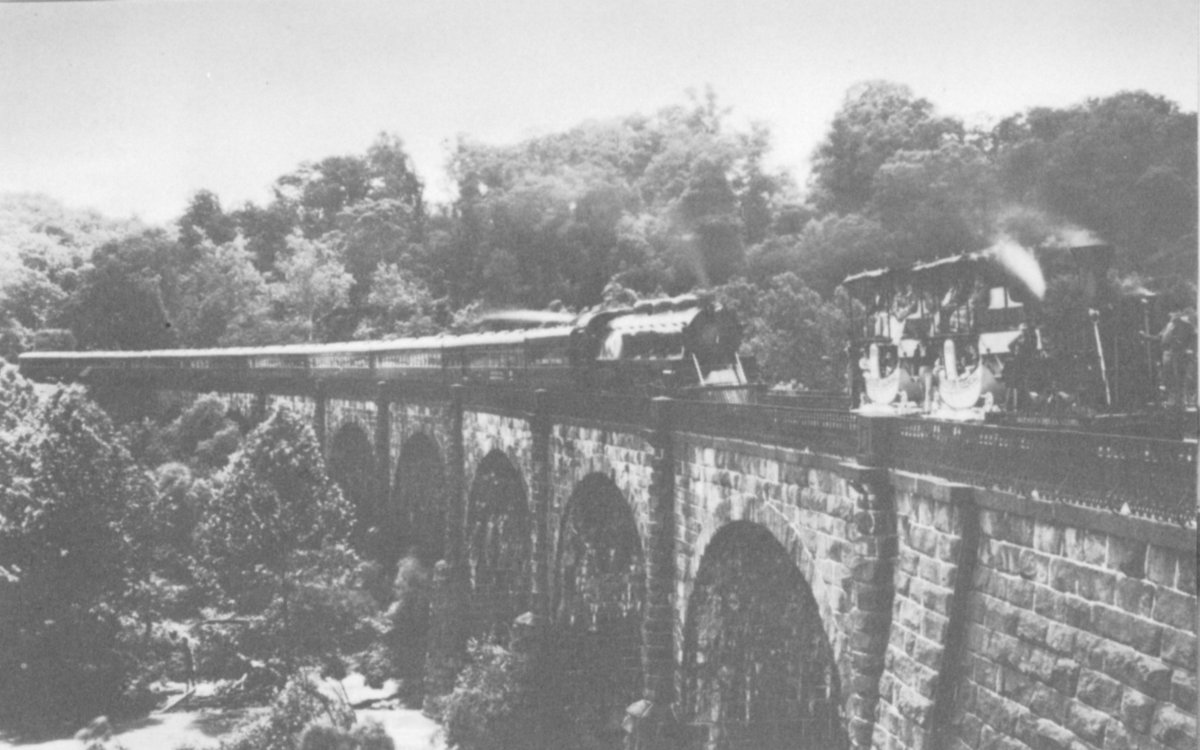
The Thomas Viaduct on the B & O between Baltimore and Washington spanning the Patapsco River is the oldest railroad stone viaduct in the world. Built in 1835, many said it would not even support the three-and-a-half-ton Grasshoppers. Yet it has never faltered under the heaviest of modern trains.
So, once more I found myself on a gondola, riding in style over the mountains to the West. And finally I reached Dayton on November 6. Then the celebration began. A big crane lifted me, light as you please, out of the car on to a heavy trailer that was used to haul me over to the park. And who do you think was down at the siding to welcome me? None other than Colonel Deeds, himself! And with him were Messrs. E. D. Smith, NCR plant engineer; R. H. Hagerman, NCR traffic manager; Carl Beust, head of NCR Patent Department; T. J. Klauenberg, B & O division superintendent; C. P. Mabie, B & O division freight agent, and M. C. Schwab, B & O freight agent. They were so pleased at my coming to town that they had a big luncheon to celebrate, and my picture was in the papers and everything.
And you should see the beautiful house they built for me at the Park. It looks just like an old railroad station, except I am inside instead of the passengers. It is built on part of the old railroad on the south bank of the old Miami and Erie Canal. It’s a beautiful setting in which to house an old locomotive as important as I am.
So, here I am, proud as a peacock in my new home. Come out and see me sometime. I expect to be here for a long, long time. As long as America is a great, free country—forever, I hope!

The development of the locomotive has continued over the years to the giant Diesels of today. The “Memnon” was built in 1848, and called the “Old War Horse” for its Civil War service.

This was the modern locomotive of 1896, built for fast passenger service between Philadelphia and Washington. It was designed by the superintendent of motive power of the B & O.

A modern steam locomotive used to haul fast merchandise freight trains in mountainous districts and for general freight road service. Built by Baldwin Locomotive Works in 1944.
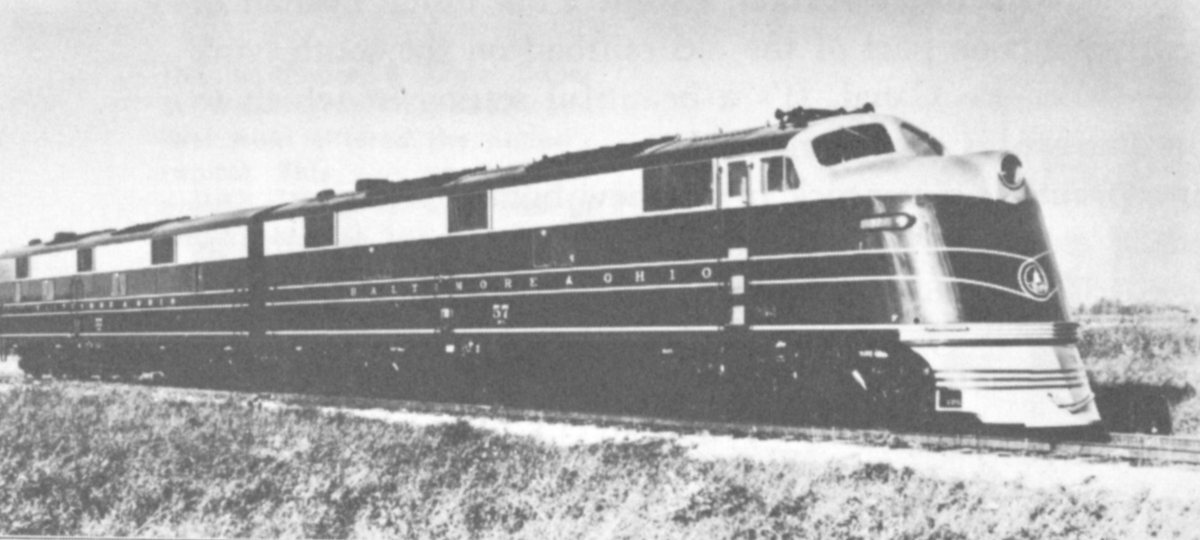
Two-unit, 4,000-horsepower, Diesel-electric locomotive used for hauling heavy passenger trains. On the basis of performance the Diesel seems well on the way to replacing the steam locomotive.
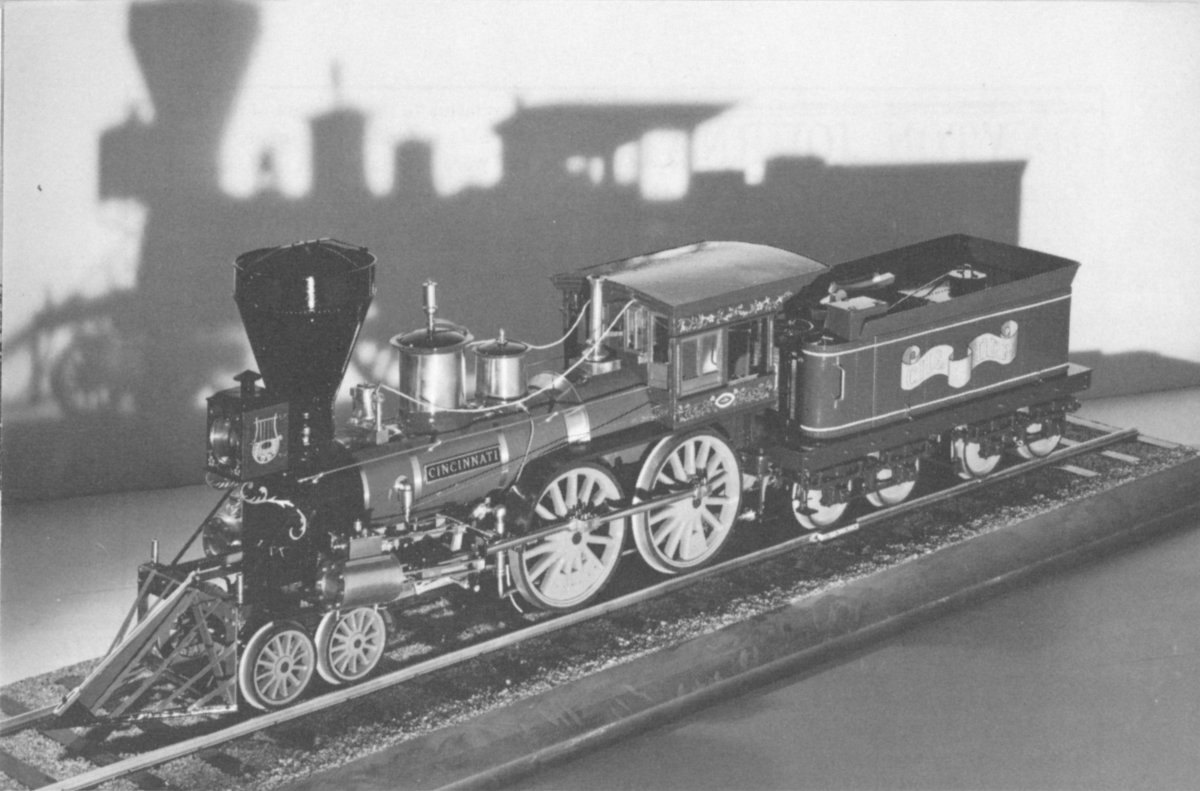
Replica in miniature of the “Cincinnati,” first locomotive to pull a passenger train into Dayton on the old Cincinnati, Hamilton & Dayton Railroad, which later became part of the Baltimore & Ohio system.
The “Cincinnati”
The “Cincinnati,” prototype of the replica in miniature on display in Deeds Barn, was typical of the locomotives that in the 1850’s were beginning to establish a new transportation network across Ohio and the Middle West.
These locomotives and their successors were to doom the canal system which played such an important role in development of the West. Although the Miami and Erie Canal—which linked Dayton to Cincinnati and Toledo—had its peak year in 1851 when the “Cincinnati” first steamed into Dayton, canal operating expenses outran revenue only five years later. In 1877, official operation of the canal ended. In the march of progress, the railroad had won.
The “Cincinnati” was built by the Harkness firm of Cincinnati, and was one of the most advanced locomotives of its day. Its honest functionalism, as evidenced by the businesslike cow-catcher and the monstrous stack designed to trap dangerous wood sparks, makes this type of locomotive, called an “American,” a favorite with railroad fans.
How long the “Cincinnati” remained in service with the C. H. & D. Railroad, and its ultimate fate are not known, but the colorful locomotive and others of its kind made possible significant gains in man’s never-ending quest for better transportation.
The Railroad Reaches Dayton
On January 27, 1851 the first locomotive to enter Dayton traveled over the newly constructed road between Springfield and Dayton. Oddly, enough, the event attracted no great attention.
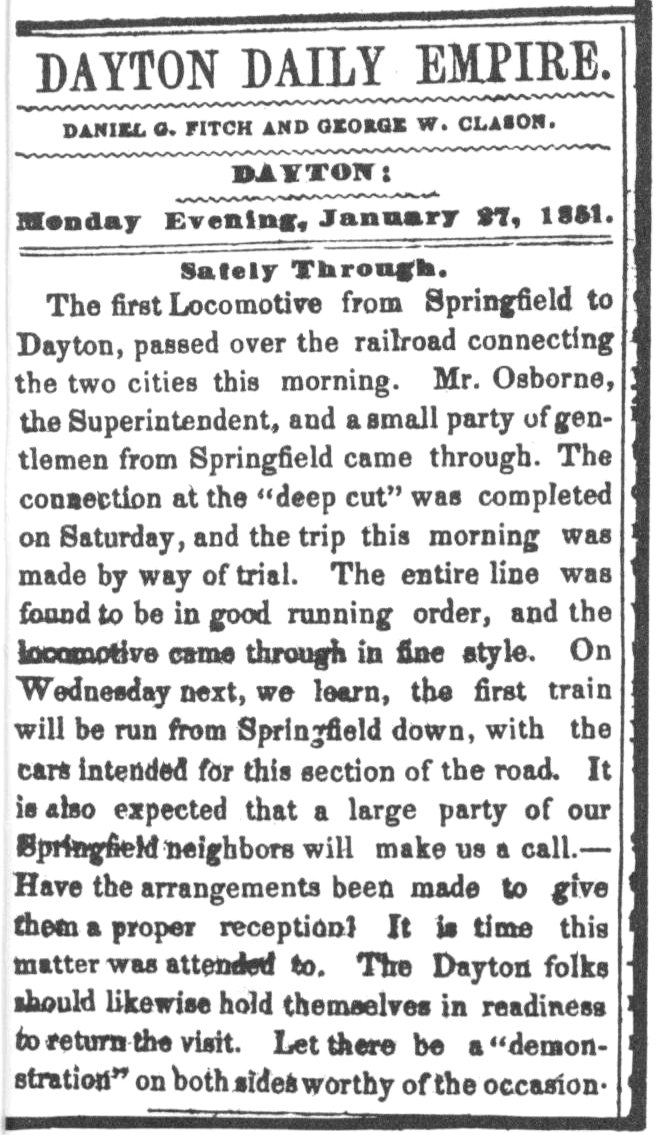
The clipping shows the passing comment made by the “Dayton Daily Empire.”
DAYTON DAILY EMPIRE.
DANIEL G. SETON AND GEORGE W. CLASON.
DAYTON:
Monday Evening, January 27, 1851.
Safely Through.
The first Locomotive from Springfield to Dayton, passed over the railroad connecting the two cities this morning. Mr. Osborne, the Superintendent, and a small party of gentlemen from Springfield came through. The connection at the “deep cut” was completed on Saturday, and the trip this morning was made by way of trial. The entire line was found to be in good running order, and the locomotive came through in fine style. On Wednesday next, we learn, the first train will be run from Springfield down, with the care intended far this section of the road. It is also expected that a large party of our Springfield neighbors will make us a call.—Have the arrangements been made to give than a proper reception? It is time this matter was attended to. The Dayton folks should likewise hold themselves in readiness to return the visit. Let there be a “demonstration” on both sides worthy of the occasion.
However, in September the same year when regular service began to Cincinnati, the arrival of the first train was the occasion of quite a memorable celebration. These illustrations show one of the first trains, newspaper comment, program for the opening, and Dayton’s Union Station of early days.
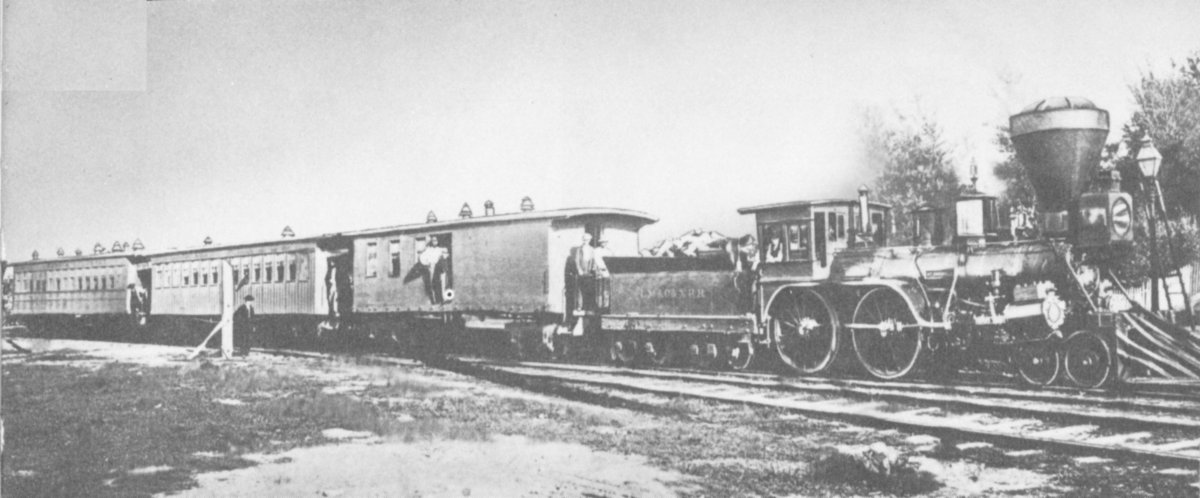
This illustration shows one of the first trains to Cincinnati.
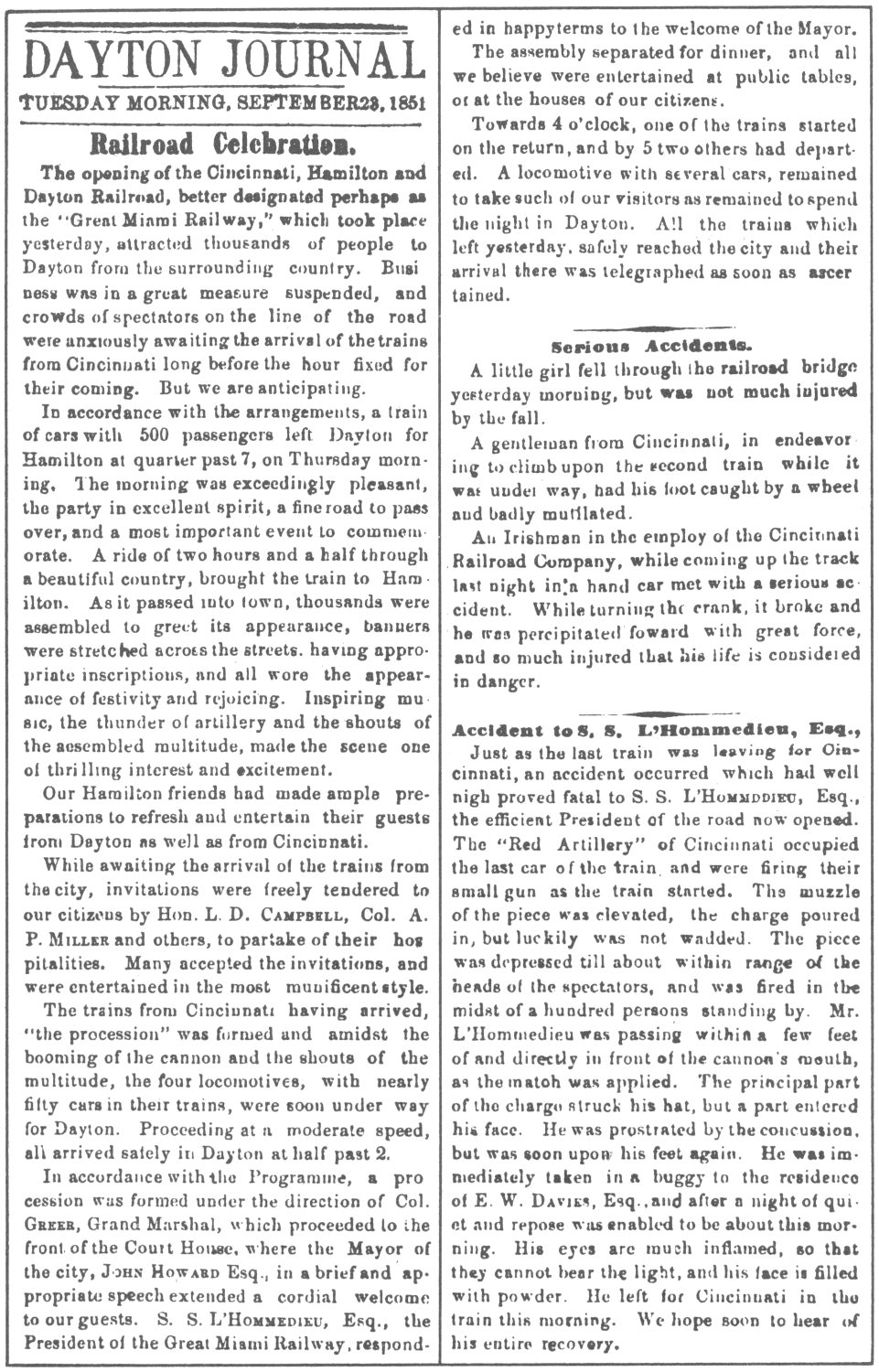
A newspaper account of the grand opening of the old Cincinnati, Hamilton & Dayton Railroad. The “Cincinnati” was the first of the trains to arrive in Dayton that day. Although “buried” deep in the article about the railroad’s opening, the bizarre accident that almost cost the life of the road’s president, S. S. L’Hommedieu, is probably one of the strangest in railroading history. According to later newspaper accounts, Mr. L’Hommedieu recovered from his injuries.
DAYTON JOURNAL
TUESDAY MORNING, SEPTEMBER 23, 1851
Railroad Celebration.
The opening of the Cincinnati, Hamilton and Dayton Railroad, better designated perhaps as the “Great Miami Railway,” which took place yesterday, attracted thousands of people to Dayton from the surrounding country. Business was in a great measure suspended, and crowds of spectators on the line of the road were anxiously awaiting the arrival of the trains from Cincinnati long before the hour fixed for their coming. But we are anticipating.
In accordance with the arrangements, a train of cars with 500 passengers left Dayton for Hamilton at quarter past 7, on Thursday morning. The morning was exceedingly pleasant, the party in excellent spirit, a fine road to pass over, and a most important event to commemorate. A ride of two hours and a half through a beautiful country, brought the train to Hamilton. As it passed into town, thousands were assembled to greet its appearance, banners were stretched across the streets, having appropriate inscriptions, and all wore the appearance of festivity and rejoicing. Inspiring music, the thunder of artillery and the shouts of the assembled multitude, made the scene one of thrilling interest and excitement.
Our Hamilton friends had made ample preparations to refresh and entertain their guests from Dayton as well as from Cincinnati.
While awaiting the arrival of the trains from the city, invitations were freely tendered to our citizens by Hon. L. D. Campbell, Col. A. P. Miller and others, to partake of their hospitalities. Many accepted the invitations, and were entertained in the most munificent style.
The trains from Cincinnati having arrived, “the procession” was formed and amidst the booming of the cannon and the shouts of the multitude, the four locomotives, with nearly fifty cars in their trains, were soon under way for Dayton. Proceeding at a moderate speed, all arrived safely in Dayton at half past 2.
In accordance with the Programme, a procession was formed under the direction of Col. Greer, Grand Marshal, which proceeded to the front of the Court House, where the Mayor of the city, John Howard, Esq., in a brief and appropriate speech extended a cordial welcome to our guests. S. S. L’Hommedieu, Esq., the President of the Great Miami Railway, responded in happy terms to the welcome of the Mayor.
The assembly separated for dinner, and all we believe were entertained at public tables, or at the houses of our citizens.
Towards 4 o’clock, one of the trains started on the return, and by 5 two others had departed. A locomotive with several cars, remained to take such of our visitors as remained to spend the night in Dayton. All the trains which left yesterday, safely reached the city and their arrival there was telegraphed as soon as ascertained.
Serious Accidents.
A little girl fell through the railroad bridge yesterday morning, but was not much injured by the fall.
A gentleman from Cincinnati, in endeavoring to climb upon the second train while it was under way, had his foot caught by a wheel and badly mutilated.
An Irishman in the employ of the Cincinnati Railroad Company, while coming up the track last night in a hand car met with a serious accident. While turning the crank, it broke and he was precipitated forward with great force, and so much injured that his life is considered in danger.
Accident to S. S. L’Hommedieu, Esq.
Just as the last train was leaving for Cincinnati, an accident occurred which had well nigh proved fatal to S. S. L’Hommedieu, Esq., the efficient President of the road now opened. The “Red Artillery” of Cincinnati occupied the last car of the train, and were firing their small gun as the train started. The muzzle of the piece was elevated, the charge poured in, but luckily was not wadded. The piece was depressed till about within range of the heads of the spectators, and was fired in the midst of a hundred persons standing by. Mr. L’Hommedieu was passing within a few feet of and directly in front of the cannon’s mouth, as the match was applied. The principal part of the charge struck his hat, but a part entered his face. He was prostrated by the concussion, but was soon upon his feet again. He was immediately taken in a buggy to the residence of E. W. Davies, Esq., and after a night of quiet and repose was enabled to be about this morning. His eyes are much inflamed, so that they cannot hear the light, and his face is filled with powder. He left for Cincinnati in the train this morning. We hope soon to hear of his entire recovery.
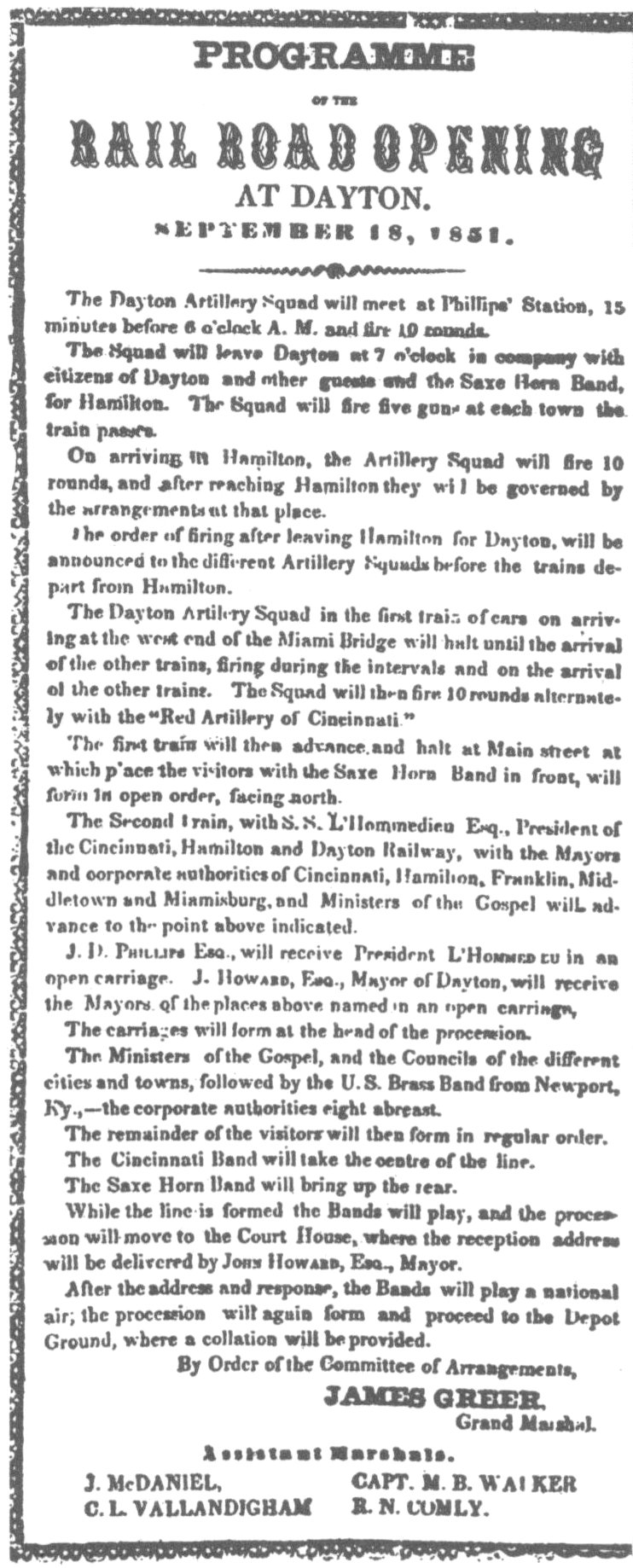
Program for the opening
PROGRAMME
OF THE
RAIL ROAD OPENING
AT DAYTON,
SEPTEMBER 18, 1851.
The Dayton Artillery Squad will meet at Phillips’ Station, 15 minutes before 6 o’clock A. M. and fire 10 rounds.
The squad will leave Dayton at 7 o’clock in company with citizens of Dayton and other guests with the Saxe Horn Band, for Hamilton. The Squad will fire five guns at each town the train passes.
On arriving in Hamilton, the Artillery Squad will fire 10 rounds, and after reaching Hamilton they will be governed by the arrangements at that place.
The order of firing after leaving Hamilton for Dayton, will be announced to the different Artillery Squads before the trains depart from Hamilton.
The Dayton Artillery Squad in the first train of cars on arriving at the west end of the Miami Bridge will halt until the arrival of the other trains, firing during the intervals and on the arrival of the other trains. The Squad will then fire 10 rounds alternately with the “Red Artillery of Cincinnati.”
The first train will then advance and halt at Main street at which place the visitors with the Saxe Horn Band in front, will form in open order, facing north.
The Second train, with S. M. L’Hommedieu, Esq., President of the Cincinnati, Hamilton and Dayton Railway, with the Mayors and corporate authorities of Cincinnati, Hamilton, Franklin, Middletown and Miamisburg, and Ministers of the Gospel will advance to the point above indicated.
J. D. Putnam, Esq., will receive President L’Hommedieu in an open carriage. J. Howard, Esq., Mayor of Dayton, will receive the Mayors of the places above named in an open carriage.
The carriages will form at the head of the procession.
The Ministers of the Gospel, and the Councils of the different cities and towns, followed by the U.S. Brass Band from Newport, Ky.,—the corporate authorities eight abreast.
The remainder of the visitors will then form in regular order.
The Cincinnati Band will take the centre of the line.
The Saxe Horn Band will bring up the rear.
While the line is formed the Bands will play, and the procession will move to the Court House, where the reception address will be delivered by James Howard, Esq., Mayor.
After the address and response, the Bands will play a national air; the procession will again form and proceed to the Depot Ground, where a collation will be provided.
By Order of the Committee of Arrangements,
JAMES GREER,
Grand Marshal.
Assistant Marshals.
J. McDANIEL,
C. L. VALLANDIGHAM
CAPT. M. B. WALKER
E. N. COMLY

Dayton’s Union Station of early days.
The Corliss Engine

George H. Corliss
Born in North Easton, Washington County, New York, George H. Corliss started out to work in a general store. At twenty-one he was the proprietor of his own store. It was an incident which happened there that set him forth on a career as an inventor. A customer complained of a pair of boots which ripped at the seams. Corliss thought there ought to be a better way to sew and in the process of trying to find it, invented a sewing machine in 1843, three years before Elias Howe received his patent. That was his first step as an inventor and it was followed by many other inventions.
The Corliss steam engine improvements, at the time of their invention and for many years thereafter, represented the most effective device ever designed for economizing in the use of steam and regulating the steadiness of a steam engine’s power and speed. These were essential steps if man was to harness the power of steam and turn it to practical use.
Before the advent of the Corliss engine, those engines which were available were very wasteful in their use of fuel to produce steam and its resultant power. They were also unable to maintain even speeds in driving factory machinery and other units. This uneven flow of power was a serious handicap to those who wanted to use steam to turn the wheels of industry.
The secret of the efficiency of the Corliss engine lay in its most distinctive feature ... the Corliss cut-off valve gear. The cut-off was automatically controlled by the governor regardless of power variations and without any slowing in speed. This was fundamentally responsible for the Corliss’ efficiency and savings in fuel. So efficient was the engine that the inventor often agreed to sell his product under an agreement that the saving in fuel cost by the end of a certain period would be its price. In one case, after the engine had run through the stated period of two years, the purchaser was glad to pay twice the list price rather than the much higher amount represented by actual savings.
The Corliss engine has played no small part in the development of Dayton industry. Two such engines were used by The National Cash Register Company for almost fifty years. One of these has been placed in Carillon Park. In the next few pages this faithful worker for industrial progress tells some of its experiences.
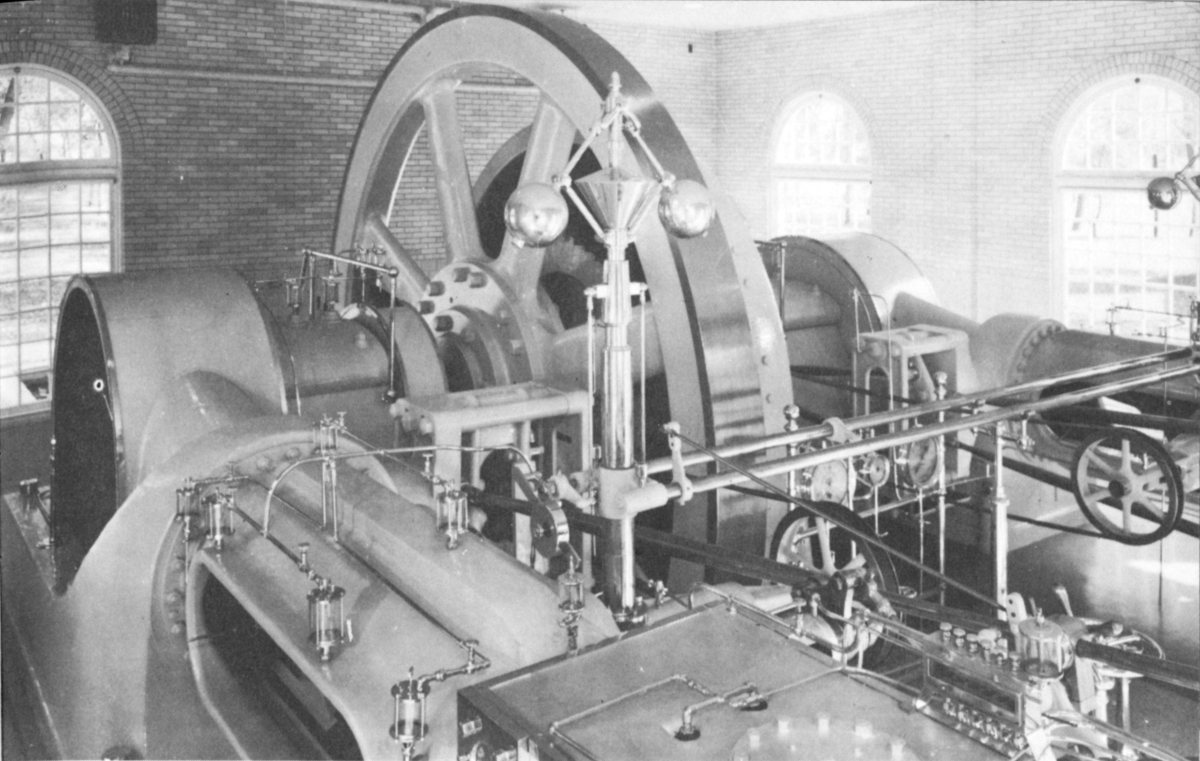
Looking over the top of the Corliss engine as installed in the miniature power house in Carillon Park.
The Story of My Life
Personal reminiscences of the Corliss engine in Carillon Park, covering nearly fifty years of continuous service.
For quite awhile now, I have been sitting over here in Carillon Park and I expect to go on doing that for some years to come. When you weigh a couple of hundred tons you don’t move around any more than you have to and once you find a good spot you are likely to “stay put.” Through the windows of my comfortable little power house I look out at my neighbors across the way. One of them is a Grasshopper locomotive which I can just see through the windows of his “station.”
I haven’t actually met “Grasshopper” but I did learn not long ago that he has written the story of his life. I wouldn’t go so far as to say that he was “blowing off steam” but it does seem to me that if he has a story to tell I should have one too. Of course, I know that size doesn’t mean everything, but if you should weigh old “Grasshopper”—wheels, cab and all—he wouldn’t weigh nearly as much as my flywheel. But I feel that we do have several things in common ... we both know what it means to get all steamed up and we have both done a lot of work in our day.
My friend “Grasshopper” has traveled quite a bit but I think he has settled down now, just like me. They say that a rolling stone gathers no moss and certainly “Grasshopper” is bright and shiny but I don’t believe you will find much moss on me either.

Part of the Corliss on its way to the NCR power house in 1902. Five teams were required to move it.
My ancestry doesn’t go back quite as far as “Grasshopper’s” but the difference is only about thirteen years, at that. He was born in 1835 and was the second generation of his family. True enough, I came along a good many years later but my forefathers reach back to 1848, for in that year the Corliss line was begun. In the following year, on March 10, 1849, Mr. George H. Corliss, a remarkable man whose name I bear, was granted his first patent for steam engine improvements embodying his famous “drop cut-off valve gear.” He had developed some new ideas about steam engines, mostly about making them run steadier and on less coal. Those ideas meant a lot to industry all over this country. Outside of the teammate who worked next to me in the NCR power house for years, I never met any of my brothers but I am sure they were all hard workers who gave a good account of themselves.
Like anybody else, I don’t remember much about my birth. I was built in Mount Vernon, Ohio, by the C. & G. Cooper Company, which manufactured Corliss engines. My various pieces never really met until they all came together in the NCR power house back there in 1902. As I remember, it was a rather bumpy ride from the freight yards to the NCR factory but I felt quite important. Who wouldn’t, with five teams of horses pulling you along and people stopping to look at you all along the way. I gather that I was considered quite a fellow in engine circles in those days and I guess folks figured if the people at NCR went out and hired a big engine like me to work for them business must be good and expected to get better.
I really don’t know who figured out all the intricate variations in my anatomy but I have heard that E. A. Deeds, who was an engineer at NCR in those days, asked them to put in some special features which he thought would make me better. Those ideas must have been all right, for I have never known a sick day in my life. And for the record, let me say that I was running full speed right up to the moment I was shut off, in 1948. That had happened before when they made me stop to be looked over but they always let me start up again. Glad I didn’t know what was happening that day for I certainly had no idea of 15 quitting, and I wouldn’t have liked the idea a bit. Of course, I came out all right, but for a while things looked pretty dark, I can tell you.

The Corliss as it looked in the NCR power house in 1902 where it functioned for almost fifty years with never a single failure.
As a matter of fact, according to the story I have pieced together from chance bits of conversation, I missed the scrap heap by just a hair. It seems there was some idea of putting only my fly wheel in Carillon Park, because they didn’t quite want to see me pass out altogether. Then one day, Colonel Deeds got the idea of putting all of me over here. He said there were not too many Corliss engines around and that we were getting fewer every year. He figured that future generations ought to know what we looked like, because we had done a good job. So, in the nick of time, he saved me. Nick of time is right! It was a matter of hours. The scrap man had already been out to look me over and I could almost feel the hot breath of the acetylene torch eating right into me.

On March 13, 1948, Colonel E. A. Deeds turned the control wheel which shut down the Corliss for the last time. It was an act which brought with it many memories for him because 46 years before he had turned that same wheel in the reverse direction for the first time and brought the Corliss to life.
Now maybe before I go any further, I should tell you what I did for almost fifty years at NCR. I really had two jobs: one to turn out electric 16 power and the other to heat the factory with my exhaust steam, which you might say I did with my left hand. That’s one reason they always liked me. I used a lot of coal—guess I’ve burned up about 175,000 tons in my day—but I never wasted it. I got just about as much out of a ton of coal as I possibly could and then I did that extra job of heating the factory with my exhaust steam for practically nothing.

The Corliss moves again but this time one powerful motor truck with heavy-duty trailer is sufficient to do the job.
I could tell you a lot about some of the things that happened during my almost half century on the job. Of course I saw NCR grow up. When I went to work in the power house there were just 5 buildings in the whole plant. When they took me out I was amazed at how the place had changed. I had seen some of the new buildings out the window but by no means all of them. There are over 30 now. And what a lot more people there are! I think there were about 2,000 in 1902 and now there are 15,000. Well, I like to think I did my share in helping things along.
About eleven years after I started to work, a terrible thing happened to Dayton. I am talking about the flood of 1913, and while I didn’t get wet, I knew the situation was bad. You see, the water knocked out the power houses downtown and my friends and I in the NCR power house had to step in and take over. Of course we were glad to do it and those days remain one of the great experiences of my life, but I wouldn’t want to go through that again. Or see the fine people of Dayton go through it either. Fortunately nobody needs to worry any more, for I understand they have fixed up that flood business for good.
I know people don’t like too many figures, but I’d like to give you just a few about myself. As you see me today, I weigh 210 tons. My flywheel is twenty feet in diameter and weighs 38 tons. When I was working full speed I turned out 800 kilowatts. According to people who should know and who looked me over just before I moved over 17 here, I was in just about as good shape when I went out as when I went in. Give me a little steam and my two old friends, Tom Monks and Ross Morgan, to look after me and I’d be right back in business.
You know, there is an interesting point of difference between Grasshopper’s experience and mine. He went onto the side track because bigger and more powerful engines took his job away from him. Well up to a point my experience was the same; the fellow who’s doing my job now is certainly more powerful—about six times as strong—much as I hate to admit it. But the funny part of it is, he’s a midget compared to me. Naturally, I haven’t been back to the power house since I left, but they tell me this fellow, whose name is Turbine, something or other, is hardly more than a good-sized bump on the power house floor. He weighs only one-fifth of what I do. Doesn’t seem possible that he can get more done than I did, but I know times change, and I guess engines, like everything else, change with them. Don’t think I’m critical; more power to him. If things keep on growing around there, he’s going to need it. But I just have a little hope way down deep, that once in a while someone is going to look over that way and think back to the days when they could see my old flywheel whirling around day and night, trying to keep things going.
You know, when you have spent your life trying to do the right thing, you like to feel that you have done a good job. Do you know the last thing they said about me, just before I moved? This is part of the Company’s records so it’s official and it’s something I’ll always remember. Here it is: “This engine has given excellent service and no power interruptions were ever experienced due to failure of this unit.” That makes a fellow feel pretty good and being over here in Carillon Park, looking shinier even than when I was on the job, makes me feel good, too. I know I am going to meet a lot of fine people and I hope they’ll enjoy coming in and looking me over. You know, I think that even for a Corliss ... I’m a very lucky fellow.
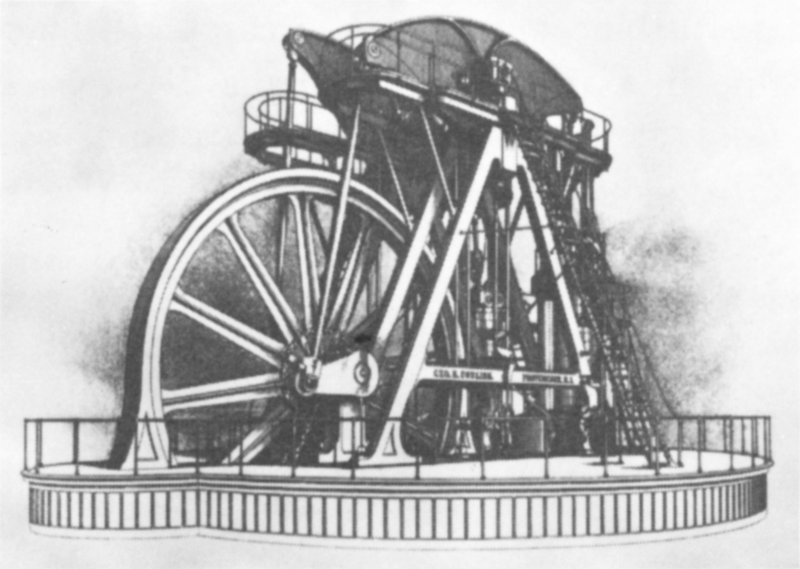
Corliss engine which furnished power for the Centennial Exhibition in Philadelphia in 1876.

The Grasshopper locomotive in Carillon Park weighs about 28,900 pounds, cost probably $4,000, and had a theoretical tractive effort of 5,094 pounds.

A modern two-unit Diesel passenger locomotive, on the other hand, weighs 630,000 pounds, costs about $400,000, and has a starting tractive effort of 107,000 pounds. The Grasshopper’s top speed was 15 miles per hour, while most passenger Diesels are geared to about 90 to 100 miles per hour.
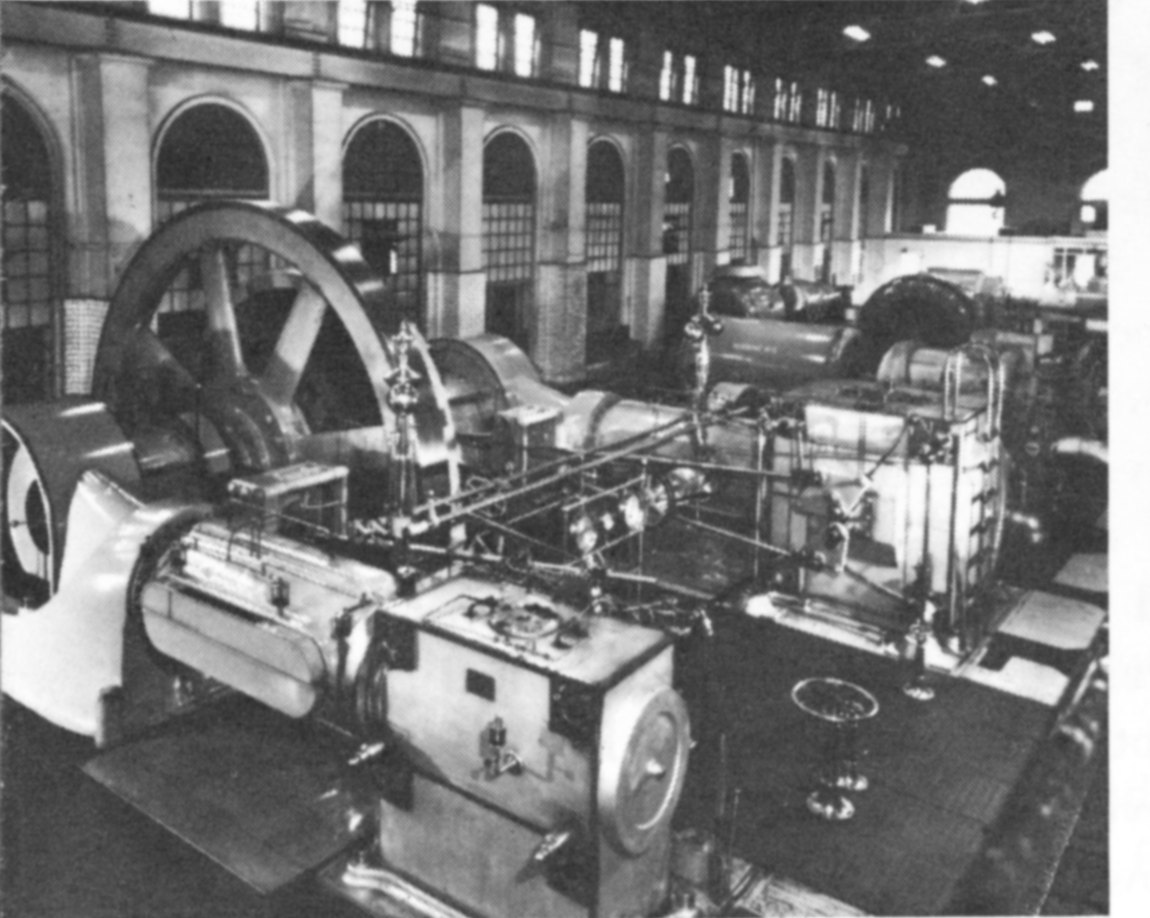
The Corliss was for many years the most efficient engine built, but the modern steam turbine gives much greater efficiency at lower cost. The Corliss engine in Carillon Park weighs 210 tons. It occupied 950 square feet of floor area and its maximum output was 800 kilowatts.
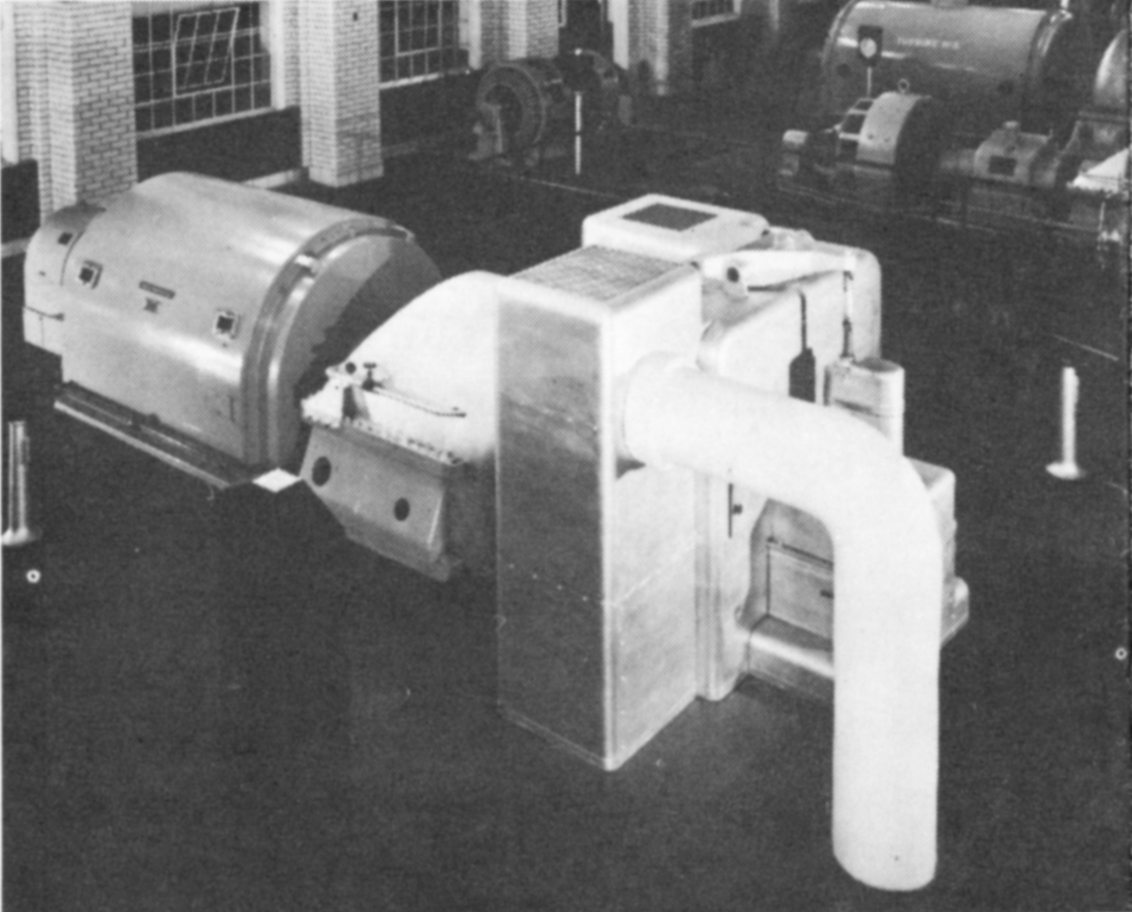
The turbo-generator, which replaced it, weighs 44 tons and occupies 200 square feet, but develops 5,000 kilowatts, or more than 25 times as much power per square foot of floor space as the Corliss.
CARILLON PARK
DAYTON, OHIO
One of a series of Carillon Park booklets.
Price ten cents.
PRINTED IN U.S.A.


